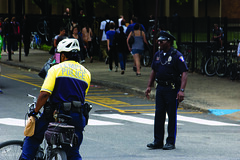Campus Police work to keep students safe, but say they need students to take measures to protect themselves and act as eyes and ears for campus safety.

Recent assaults involving Temple students have many concerned about their safety on and off campus.
On Aug. 20, a Temple student was shot and robbed for his iPhone near 13th Street and Girard Avenue.
Another student was nearly abducted Sept. 2. Police said she was walking near Temple’s Center City campus at 16th and Market streets when a man asked her for help in securing a car seat. The man forced her into the car, but she was able to escape from the vehicle when the man stopped at a red light at John F. Kennedy Boulevard.
Students said Temple and Campus Safety protect students but need to better prepare students for life in Philadelphia.
“Many students who come to Temple are not used to urban environments and some have never experienced one before beginning college,” Kyle Goldstein, a junior civil engineering major, said. “Temple ensures that students will be safe due to the extensive police force but do not prepare students how to be safe on their own.”
Some students said they feel the university is not notifying students of these incidents quickly enough.
“I understand that they notified us about the [Center City incident] because it was near that campus, but they should’ve also notified us when the Temple student got shot back in August,” junior biology major Jenna Mechalas said.
Donna Gray, special services coordinator for Campus Safety Services, said an e-mail notification was sent out the day after the attempted abduction.
She said she was unsure why a similar notification was not issued after the August shooting and emphasized that students should always follow the basic methods of risk reduction.
“Unless you have someone shadowing you 24 hours a day, you can’t rely on anyone for your safety,” Gray said.
She said Campus Police respond to reports but need students to be the eyes and ears for campus and inform the department immediately of any such incidents.
Risk reduction includes students programming the Campus Police phone number, 215-204-1234, in their cell phones or committing it to memory, Gray said. It also includes safety in numbers – avoiding walking alone, especially at night.
“Students are busy people, and they’ve all got a lot on their mind,” Gray said. “When you aren’t paying attention [while walking around campus], it’s important to have others with you who can pick up on things you don’t.”
Gray says that the Campus Safety Services Web site includes resources to help students become more aware. A daily crime log is published on the site, and the 2008 Annual Crime Statistics will be made available on the site after October, she said.
“One of the things I’m struck by is that it’s difficult to balance the idea of having people be aware versus people getting scared,” Gray added. “I think it’s important for people to be aware that anything could happen at any time to anyone, but that’s not something you should be scared about.”
Gray also spoke about a special self-defense class she is teaching, Rape-Aggression Defense. The two-credit course, which is offered through the Kinesiology department, aims at improving students’ awareness and risk reduction, as well as encouraging empowerment.
The only restriction is that the course is for women only, an aspect some students disagree with.
“I think males should get as much defense training as females,” Christina Graham, a senior public health major, said. “My friend got attacked over his cell phone. It’s not completely fair.”
Ryan Boskie, a junior human resources management major, said he doesn’t consider the females-only class sexist but said he thinks men are targeted just as often as women in acts of crime.
“I feel classes for males are needed as well,” Boskie said. “But I feel there should be a program or class geared toward fending off against [armed] or bigger attackers.”
He also added that RAD and any other self-defense classes offered at Temple should be advertised more to students.
Goldstein said he felt torn about the issue.
“I believe that both sexes should be treated equally, however, in this case, a separate class for females is acceptable, as they are more likely to be attacked than males,” he said. “But since there is a class for females, I think there should be a class for males as well because even though they are targeted less, they can still become victims.”
“We recognize that in our society, females are socialized different, so they aren’t always socialized to defend themselves,” Gray said. “Through this class, we want to encourage empowerment.
“It’s not that men might not need empowerment, and I certainly believe they need to respond to a situation if they are in danger of attack,” she added.
Gray said the Temple HapKido Club teaches self-defense for both men and women. The main goal of students, though, should not be to confront the aggressor. Instead, the best defense is to escape.
“We all need to be more aware, and we all need to step up,” she said. “Maybe the next step is to together a safety-awareness curriculum.
“When one of our students are attacked we take it very personally,” Gray added. “We really care about our students.”
Joshua Fernandez can be reached at josh@temple.edu.



Here is an article with safety tips for living in off campus housing apartments near Temple University. The tips are pretty good. Its written by a portable security alarm company, but its very well written. Here the link: http://www.protectcollegestudents.com/index_Page273.htm and also their main website http://www.protectcollegestudents.com (what they have there is also a great resource for any student living off campus in a high crime area).
Stay with this guys, you’re hleinpg a lot of people.